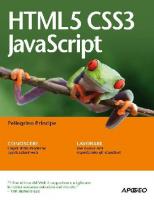HTML5, CSS3, and JavaScript: Crash Course for Building Modern Responsive, Dynamic, and User-Friendly Websites for All Devices with The Aid of Practical Exercises
This book is an essential guide for aspiring web developers and designers seeking to master the foundational technologie
132 66
English Pages 428 Year 2023
Table of contents :
TABLE OF CONTENTS
INTRODUCTION
CHAPTER ONE
GETTING STARTED WITH HTML
What is HTML?
What is New in HTML5
Why Learn HTML5
Choosing a Text Editor or IDE
Understanding HTML5 Semantic Markup
How is HTML used in Web Development?
Understanding the basic structure of an HTML document
Basic Tags and Attributes
Creating an HTML Document
Setting up an HTML Document
Adding Content to an HTML Document
Understanding HTML Tags, Attributes, and Values
Adding Comments to an HTML Document
CHAPTER TWO
HTML TEXT FORMATTING
Understanding HTML Headings
Understanding HTML Paragraphs
Understanding HTML Lists
Unordered Lists
Ordered Lists
Nested Lists
Understanding HTML links
Relative URLs
Linking to Specific Parts of a Page
How to Format Text using HTML Tags
How to Add Images to an HTML Document
How to Add Videos to an HTML Document
Using Audio in HTML5
CHAPTER THREE
UNDERSTANDING FORMS AND INPUT
Creating Forms
Text Inputs and Labels
Checkboxes and Radio Buttons
Select Menus and Option Groups
Text Areas and Buttons
Understanding Form Validation
CHAPTER FOUR
UNDERSTANDING TABLES AND LISTS
Creating Tables
Adding Rows and Columns
Styling Tables with CSS
CHAPTER FIVE
ADVANCED HTML5 FEATURES
Canvas and SVG graphics
How to Apply Canva and SVG Graphics
Understanding Web Storage
Understanding Geolocation
Understanding Web Workers
Understanding Drag and Drop
Understanding Web Sockets
Accessibility and SEO
Making your HTML5 Code Accessible
Using Semantic Markup
Applying Semantic Markup
Optimizing for Search Engines
CHAPTER SIX
HTML PRACTICAL EXERCISES
Exercise 1: Creating a Login Page
Exercise 2: Creating a Registration Page
Exercise 3: Create a Simple Personal Portfolio Website
CHAPTER SEVEN
INTRODUCTION TO CSS
What is CSS?
How is CSS used in Web Development?
How CSS works with HTML
Understand the Difference Between CSS and HTML
Benefits of using CSS
Basic CSS Syntax
Writing CSS rules
Selectors and Declarations
Comments in CSS
External and Internal CSS
Linking an External CSS
CHAPTER EIGHT
CSS STYLE PROPERTIES
Text Properties
What are CSS Text Properties?
Applying Text Properties
Font Properties
Applying Font Properties
Color Properties
Applying Color properties
Background Properties
CSS Box Model
Applying CSS Box Model
Understanding the Box Model
Margin, Border, and Padding
Width and Height
CSS Layouts
CSS Floats
Applying Float
Positioning
Applying Positioning
Display
Applying Display
Understanding CSS Grid
Applying CSS Grid
CSS Animations
Applying CSS Animations
CSS transitions
Animating with Keyframes
Undesratanding Flexbox
Applying Flexbox
CSS Variables
Scalable Vector Graphics (SVG)
Writing Efficient CSS
Debugging CSS
The Future of CSS
CHAPTER NINE
HTML AND CSS PRACTICAL EXERCISES
Exercise 1: Design a simple login page with HTML and CSS
Exercise 2: Build a simple landing page for a product with HTML and CSS.
Exercise 3: Create a responsive pricing table with HTML and CSS
CHAPTER TEN
RESPONSIVE WEB DESIGN
Introduction to Responsive Design
Best Practices for Designing Responsive Websites
Tools and Technologies used to Create Responsive Website
Understanding Media Queries
Applying Media Queries
Understanding Mobile-first Design Approach
Applying Mobile-first Design
Responsive Frameworks
Common Challenges and Solutions Associated with Responsive Web Design
Optimizing Images and Managing Complex Layouts
CHAPTER ELEVEN
RESPONSIVE WEBSITES PRACTICAL EXERCISES
Exercise 1: Design a responsive restaurant website
Exercise 2: Create a Responsive Photographer Portfolio
Exercise 3: Develop a Responsive E-commerce Website
CHAPTER TWELVE
GETTING STARTED WITH JAVASCRIPT
WHAT EXACTLY IS JAVASCRIPT
HISTORY OF JAVASCRIPT
FEATURES OF JAVASCRIPT
DIFFERENCES BETWEEN JAVASCRIPT AND OTHER PROGRAMMING LANGUAGES
UNDERSTANDING OBJECT-ORIENTED PROGRAMMING
SETTING UP JAVASCRIPT DEVELOPMENT ENVIRONMENT
HOW TO CONFIGURE VISUAL STUDIO CODE TO RUN JAVASCRIPT
CHAPTER THIRTEEN
JAVASCRIPT BASICS
JAVASCRIPT VARIABLES
Strings:
Numbers:
Booleans:
Objects:
Arrays:
DECLARING VARIABLES
WORKING WITH STRINGS, NUMBERS, AND BOOLEAN VALUES
WORKING WITH STRINGS
Declaring a String Variable
Accessing Individual Characters in a String
Concatenating Strings
WORKING WITH NUMBERS
Declaring a Number Variable
WORKING WITH BOOLEANS
Using Boolean Operators
UNDERSTANDING OBJECTS AND ARRAYS
Understanding Objects
Declaring Objects
Understanding Arrays
Declaring Arrays
CHAPTER FOURTEEN
OPERATORS AND EXPRESSIONS
ARITHMETIC OPERATORS
Addition (+):
Subtraction (-):
Multiplication (*):
Division (/):
Modulo (%):
COMPARISON OPERATORS
Equal to (==):
Not Equal to (!=):
Greater than (>), than (=), less than or equal to (
TABLE OF CONTENTS
INTRODUCTION
CHAPTER ONE
GETTING STARTED WITH HTML
What is HTML?
What is New in HTML5
Why Learn HTML5
Choosing a Text Editor or IDE
Understanding HTML5 Semantic Markup
How is HTML used in Web Development?
Understanding the basic structure of an HTML document
Basic Tags and Attributes
Creating an HTML Document
Setting up an HTML Document
Adding Content to an HTML Document
Understanding HTML Tags, Attributes, and Values
Adding Comments to an HTML Document
CHAPTER TWO
HTML TEXT FORMATTING
Understanding HTML Headings
Understanding HTML Paragraphs
Understanding HTML Lists
Unordered Lists
Ordered Lists
Nested Lists
Understanding HTML links
Relative URLs
Linking to Specific Parts of a Page
How to Format Text using HTML Tags
How to Add Images to an HTML Document
How to Add Videos to an HTML Document
Using Audio in HTML5
CHAPTER THREE
UNDERSTANDING FORMS AND INPUT
Creating Forms
Text Inputs and Labels
Checkboxes and Radio Buttons
Select Menus and Option Groups
Text Areas and Buttons
Understanding Form Validation
CHAPTER FOUR
UNDERSTANDING TABLES AND LISTS
Creating Tables
Adding Rows and Columns
Styling Tables with CSS
CHAPTER FIVE
ADVANCED HTML5 FEATURES
Canvas and SVG graphics
How to Apply Canva and SVG Graphics
Understanding Web Storage
Understanding Geolocation
Understanding Web Workers
Understanding Drag and Drop
Understanding Web Sockets
Accessibility and SEO
Making your HTML5 Code Accessible
Using Semantic Markup
Applying Semantic Markup
Optimizing for Search Engines
CHAPTER SIX
HTML PRACTICAL EXERCISES
Exercise 1: Creating a Login Page
Exercise 2: Creating a Registration Page
Exercise 3: Create a Simple Personal Portfolio Website
CHAPTER SEVEN
INTRODUCTION TO CSS
What is CSS?
How is CSS used in Web Development?
How CSS works with HTML
Understand the Difference Between CSS and HTML
Benefits of using CSS
Basic CSS Syntax
Writing CSS rules
Selectors and Declarations
Comments in CSS
External and Internal CSS
Linking an External CSS
CHAPTER EIGHT
CSS STYLE PROPERTIES
Text Properties
What are CSS Text Properties?
Applying Text Properties
Font Properties
Applying Font Properties
Color Properties
Applying Color properties
Background Properties
CSS Box Model
Applying CSS Box Model
Understanding the Box Model
Margin, Border, and Padding
Width and Height
CSS Layouts
CSS Floats
Applying Float
Positioning
Applying Positioning
Display
Applying Display
Understanding CSS Grid
Applying CSS Grid
CSS Animations
Applying CSS Animations
CSS transitions
Animating with Keyframes
Undesratanding Flexbox
Applying Flexbox
CSS Variables
Scalable Vector Graphics (SVG)
Writing Efficient CSS
Debugging CSS
The Future of CSS
CHAPTER NINE
HTML AND CSS PRACTICAL EXERCISES
Exercise 1: Design a simple login page with HTML and CSS
Exercise 2: Build a simple landing page for a product with HTML and CSS.
Exercise 3: Create a responsive pricing table with HTML and CSS
CHAPTER TEN
RESPONSIVE WEB DESIGN
Introduction to Responsive Design
Best Practices for Designing Responsive Websites
Tools and Technologies used to Create Responsive Website
Understanding Media Queries
Applying Media Queries
Understanding Mobile-first Design Approach
Applying Mobile-first Design
Responsive Frameworks
Common Challenges and Solutions Associated with Responsive Web Design
Optimizing Images and Managing Complex Layouts
CHAPTER ELEVEN
RESPONSIVE WEBSITES PRACTICAL EXERCISES
Exercise 1: Design a responsive restaurant website
Exercise 2: Create a Responsive Photographer Portfolio
Exercise 3: Develop a Responsive E-commerce Website
CHAPTER TWELVE
GETTING STARTED WITH JAVASCRIPT
WHAT EXACTLY IS JAVASCRIPT
HISTORY OF JAVASCRIPT
FEATURES OF JAVASCRIPT
DIFFERENCES BETWEEN JAVASCRIPT AND OTHER PROGRAMMING LANGUAGES
UNDERSTANDING OBJECT-ORIENTED PROGRAMMING
SETTING UP JAVASCRIPT DEVELOPMENT ENVIRONMENT
HOW TO CONFIGURE VISUAL STUDIO CODE TO RUN JAVASCRIPT
CHAPTER THIRTEEN
JAVASCRIPT BASICS
JAVASCRIPT VARIABLES
Strings:
Numbers:
Booleans:
Objects:
Arrays:
DECLARING VARIABLES
WORKING WITH STRINGS, NUMBERS, AND BOOLEAN VALUES
WORKING WITH STRINGS
Declaring a String Variable
Accessing Individual Characters in a String
Concatenating Strings
WORKING WITH NUMBERS
Declaring a Number Variable
WORKING WITH BOOLEANS
Using Boolean Operators
UNDERSTANDING OBJECTS AND ARRAYS
Understanding Objects
Declaring Objects
Understanding Arrays
Declaring Arrays
CHAPTER FOURTEEN
OPERATORS AND EXPRESSIONS
ARITHMETIC OPERATORS
Addition (+):
Subtraction (-):
Multiplication (*):
Division (/):
Modulo (%):
COMPARISON OPERATORS
Equal to (==):
Not Equal to (!=):
Greater than (>), than (=), less than or equal to (

- Similar Topics
- Computers
- Programming








![HTML5, CSS3 и JavaScript. Исчерпывающее руководство [4 ed.]
9785699676033](https://ebin.pub/img/200x200/html5-css3-javascript-4nbsped-9785699676033.jpg)
